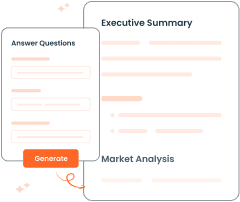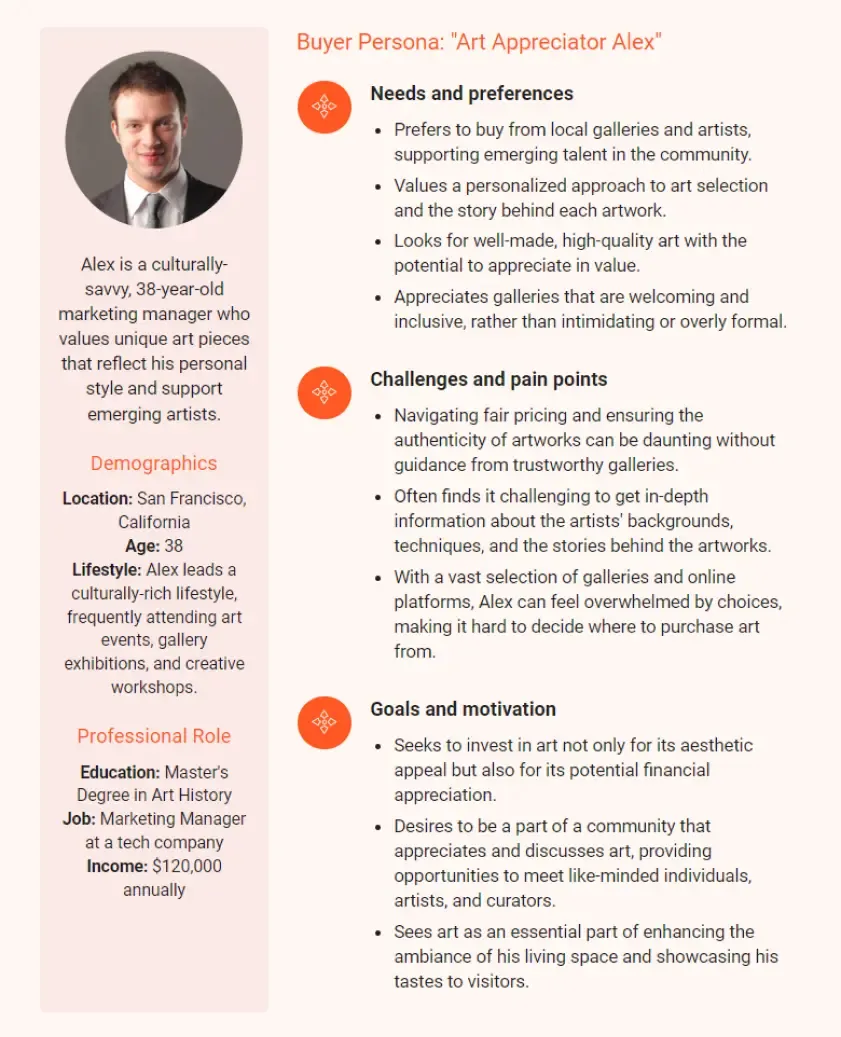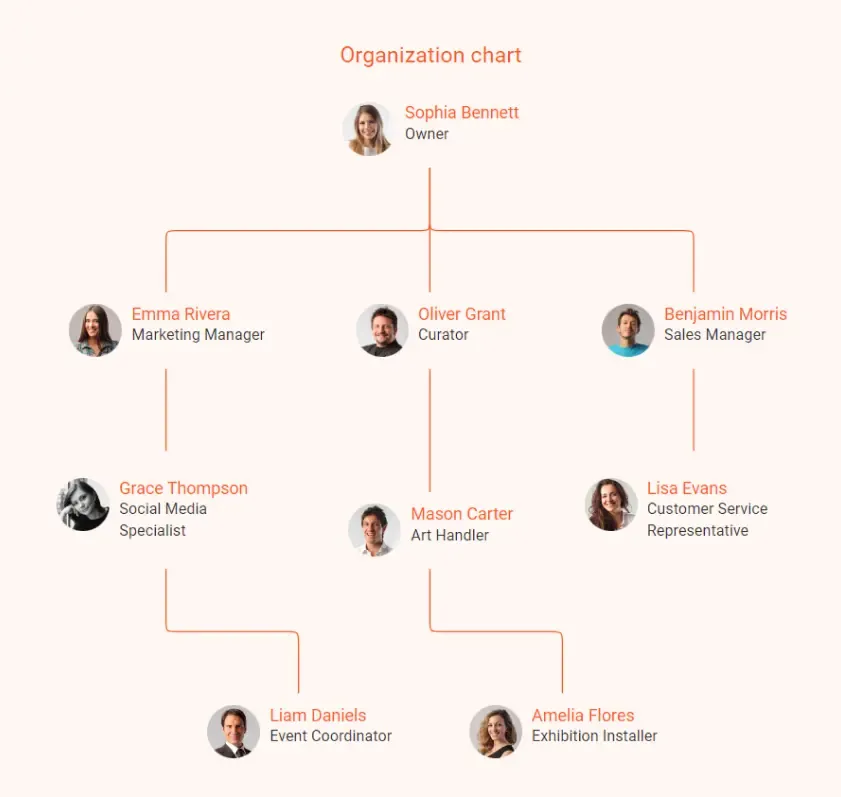Opening and growing a successful art gallery is a dream come true for many art enthusiasts and creators!
Well, it’s an exciting venture that combines creativity with passion.
But transforming that artistic vision into a stunning gallery demands more than just showcasing the wonderful art pieces. It requires a solid business plan to navigate the complexities of the art market and manage finances effectively.
Wondering how to create one?
Not to worry! This comprehensive guide and a free art gallery business plan template will help you get started. Let’s dive right in!
How to write an art gallery business plan?
When writing an art gallery business plan, it’s crucial to cover all the key sections that describe your goals, strategies, and financial projections. Here’s a detailed guide:
1) Executive summary
An executive summary is the most important section of an art gallery business plan as it offers a quick, high-level introduction to your art gallery.
Though it appears first in the plan, it’s best to write your executive summary at the end when you’ve completed the other sections. Why? Because it allows you to summarize all the key points more clearly and effectively.
Consider highlighting the following essential elements in this section:
- Your art gallery’s registered name & location
- Vision-mission statements
- Business model and its status (startup or established)
- Market opportunity and target audience
- Unique aspects of your art gallery
- Marketing tactics
- Financial highlights (e.g., expected revenue, profitability)
In short, the executive summary captures the essence of your art gallery and attracts potential investors or stakeholders to delve into the rest of your plan.
So, try to make your plan summary clear, concise, and compelling. Also, use simple, jargon-free terms.
Liking the plan you're reading? It's AI generated.
Generate Your Own Using Bizplanr AI
2) Company overview
The company overview section gives a comprehensive look into your art gallery venture, from its foundational facts to futuristic goals.
So, it’s a good opportunity to explain your business concept in detail and help readers (whether they're potential customers, investors, or partners) better understand your art gallery.
To plan this section carefully, consider providing a detailed description of:
- Your gallery’s concept and core values
- Legal structure (sole proprietorship, LLC, or corporation)
- Key founders and any partners involved
- Type of gallery you’re running (physical space, online gallery, or both)
- Company history (how and why you’ve started this gallery)
- Milestones or achievements (if any)
- Short-term goals and long-term objectives
Besides that, jot down the regulatory requirements and legal compliances related to the art gallery business as well as showcase how you’ll meet them.
Simply put, your business summary offers a complete picture of your business, which helps build trust and confidence in what you offer. So, keep it interesting and to the point.
3) Industry analysis
In the industry analysis section, you’ll need to provide a detailed overview of the art market in which your gallery intends to operate.
This might seem unnecessary, but it helps you in different ways:
Conducting thorough market research enables you to position your gallery within the broader art world and even gives you a clear understanding of the current industry trends, target customers, and competitors.
The following questions should be answered while drafting this section:
- What’s the size of the art gallery market globally?
- How big is the US art gallery business? Is it growing or declining?
- What is the growth potential of the market over the next 5–10 years?
- What are the recent trends and growth patterns in the art gallery industry?
- Who are the market’s major competitors?
- What are the factors that might impact the art gallery market?
4) Customer analysis
Customer analysis plays a vital role in an art gallery business plan since it evaluates the target market segments that your art gallery will serve.
It will even allow you to define your target audience, understand their needs and preferences as well as describe how your art gallery will meet those requirements.
For an art gallery, here are a few examples of customer segments:
- Art collectors and supporters
- Interior designers or decorators
- Tourists or casual shoppers
- Art enthusiasts & hobbyists
- Local community and affluent millennials
- Event planners or rental clients
Moreover, try to identify their psychographic and demographic profiles. This will help you understand your ideal clients more effectively and tailor your offerings, marketing efforts, or overall gallery experience.
Here's an example of an art gallery’s customer persona:
5) Competitive analysis
The competitive analysis section sheds light on the key competitors who you’re up against and how you can differentiate your gallery.
Start this section by identifying both direct and indirect competitors. For example:
Direct competitors: Other local galleries and online art platforms
Indirect competitors: Antique dealers and auction sites/houses
Once you’ve identified your competitors, focus on those that directly compete with your art gallery as they impose the biggest challenges. However, keep track of indirect competitors as well, just in case.
For each such competitor, analyze their business size, type of artwork, reputation, pricing, and customer base.
Also, note their strengths and weaknesses, including what they are doing well and areas where they fall short. This will give you valuable insights on potential opportunities to stand out.
Moreover, explain your art gallery’s unique points, like distinctive art style, exclusive artist representation, or an exceptional gallery atmosphere. Use these USPs to attract new customers in a competitive landscape.
6) Marketing strategy
A successful art gallery is not just about the impressive art on the walls. But it’s all about making strong connections, generating more sales, and building up a good reputation.
So, you have to find creative ways and strategies to reach your target audience, bring in potential buyers, and get new customers.
Here’s how you can outline your marketing strategy for an art gallery:
Product
Describe what you are offering. For an art gallery, the product isn’t just an artwork—it's the artwork you showcase or sell.
Consider emphasizing how these art pieces stand out from others and attract your target audience. Also, focus on:
- Art collections (contemporary, abstract, sculptures) & artists (emerging or established)
- Overall gallery experience, including lighting, layout, and atmosphere
- Additional services—Do you provide online sales, private showcasing, or art consulting?
Pricing strategy
Well, pricing in an art gallery can vary greatly based on the target market and the artists you work with. Your pricing model might include:
- Commission-based pricing depending on the artist’s reputation and the art piece's value
- Tiered pricing for established artists, beginners, and exclusive collections
- Event & service base pricing, If you host exhibitions, private viewings, or art classes
Be mindful of the perceived value of your art gallery products and services. Clearly explain how your pricing can reflect the quality of the artwork, the reputation of the artists, and market demand.
Place
Place refers to how and where potential customers will get access to your art gallery and art collections. For example:
- Gallery location and physical space—whether it’s in an art district, tourist area, or city center.
- Online presence & accessibility—whether you keep a professional website, online gallery, or sell via online art platforms.
- Art fairs, pop-up events, or additional spaces where your gallery reaches a broader audience.
Further, note down how the right place allows you to get a steady stream of customers. Also, discuss how you make your gallery visible and accessible to the ideal customers (both offline & online).
Promotions
Promotions would be the final part of your marketing plan that highlights how you communicate with potential clients.
This section involves the multiple tactics and methods you’ll use to drive awareness, draw new customers, and persuade them to buy your products or services. Here are a few strategies you might consider:
- Pre-opening events and flyer distributions
- Social media marketing through platforms, like Instagram, Facebook, or Pinterest
- Email marketing campaigns and newsletters
- Local print or online media marketing
- Paid advertising using Pay-Per-Click (PPC) or display ads
- Collaborations & partnerships with local businesses, art communities, or influencers
Make sure these strategies give a clear picture of your gallery’s brand as well as connect with your target market in engaging and authentic ways.
7) Operations plan
Your operations plan outlines how your art gallery will function on a day-to-day or weekly basis. This will showcase that your art gallery runs smoothly and all the operational aspects are managed effectively.
A well-written operations plan also helps you and your employees define responsibilities while managing everyday activities centered on achieving business goals.
So, try to detail all your operational intricacies, including:
- Staffing needs and training
- Art sourcing & inventory process
- Logistical details from art transportation, installations, and framing to hosting events
- Customer service policies
- Gallery design and ambiance—will it be minimalist, classic, or modern?
If possible, include floor plans or layout sketches to visualize your operations and enhance the credibility of your art gallery business plan.
8) Management team
In this section, introduce the gallery owner(s), key management team, and the key people responsible for smooth business operations. Also, highlight their roles and responsibilities, educational qualifications, skills, and industry experience.
This will help you weigh authority and demonstrate to potential investors that your gallery is led by a capable team that contributes to the overall success of the business.
Furthermore, you may present an organizational structure that clearly defines how roles are interconnected and how decisions are made. For instance:
If your gallery involves any advisory board members or consultants, mention them as well and discuss how they support your business.
9) Financial plan
Creating a realistic, detailed financial plan is a crucial aspect as it not only lets you forecast revenue and manage cash flows but also offers a complete picture of your gallery’s growth and profitability.
So, in your art gallery financial plan, provide a comprehensive analysis of the financial projections for the next 3-5 years. Here’s what to include:
- Gallery startup costs & initial investments
- Sales and revenue projections
- Profit & loss statement
- Cost structure (fixed and variable costs)
- Break-even analysis
- Funding requirements and use of funds
- Financing strategy (loans, investors, grants)
Further, describe your repayment methods for the borrowed amount and mention sensitivity analyses for the different scenarios.
Make sure you develop easy-to-read tables, graphs, and charts to present your financial data clearly and more effectively. This will allow potential investors or lenders to make informed decisions easily.
For example, you may consider formulating the financial forecasts as shown below:
Profit and loss statement (income statement)
| Year | Year 1 | Year 2 | Year 3 |
|---|---|---|---|
| Revenue (Art Sales) | $300,000 | $345,000 | $396,750 |
| COGS (Owned Artworks) | $60,000 | $69,000 | $79,350 |
| Gross Profit | $240,000 | $276,000 | $317,400 |
| Operating Expenses | $120,000 | $132,000 | $145,200 |
| Salaries and Wages | $80,000 | $88,000 | $96,800 |
| Marketing & Promotion | $10,000 | $11,000 | $12,100 |
| Rent | $30,000 | $33,000 | $36,300 |
| Utilities & Insurance | $10,000 | $11,000 | $12,100 |
| Total Operating Expenses | $250,000 | $275,000 | $302,500 |
| Operating Income (EBITDA) | -$10,000 | $1,000 | $14,900 |
| Depreciation & Amortization | $5,000 | $5,000 | $5,000 |
| Interest Expense | $2,000 | $1,800 | $1,500 |
| Net Profit Before Tax | -$17,000 | -$5,800 | $8,400 |
| Taxes (25%) | - | - | $2,100 |
| Net Profit (After Tax) | -$17,000 | -$5,800 | $6,300 |
Cash flow statement
| Year | Year 1 | Year 2 | Year 3 |
|---|---|---|---|
| Beginning Cash Balance | $100,000 | $53,000 | $55,600 |
| Cash Inflows | |||
| Sales Collections (90% of sales) | $270,000 | $310,500 | $357,075 |
| Loan Proceeds | $50,000 | - | - |
| Total Cash Inflows | $320,000 | $310,500 | $357,075 |
| Cash Outflows | |||
| Operating Expenses (excluding non-cash) | $230,000 | $253,000 | $278,250 |
| Loan Payments (Principal & Interest) | $10,000 | $10,000 | $10,000 |
| Capital Expenditure (Renovations, etc.) | $7,000 | $5,000 | $7,000 |
| Total Cash Outflows | $247,000 | $268,000 | $295,250 |
| Net Cash Flow | $73,000 | $42,500 | $61,825 |
| Ending Cash Balance | $53,000 | $55,600 | $67,425 |
Balance sheet
| Assets | Year 1 | Year 2 | Year 3 |
|---|---|---|---|
| Current Assets | |||
| Cash & Cash Equivalents | $53,000 | $55,600 | $67,425 |
| Accounts Receivable | $30,000 | $34,500 | $39,675 |
| Inventory (Art) | $60,000 | $69,000 | $79,350 |
| Total Current Assets | $143,000 | $159,100 | $186,450 |
| Non-Current Assets | |||
| Equipment & Fixtures | $20,000 | $20,000 | $25,000 |
| Leasehold Improvements | $30,000 | $25,000 | $20,000 |
| Total Non-Current Assets | $50,000 | $45,000 | $45,000 |
| Total Assets | $193,000 | $204,100 | $231,450 |
| Liabilities & Equity | Year 1 | Year 2 | Year 3 |
|---|---|---|---|
| Current Liabilities | |||
| Accounts Payable | $10,000 | $12,000 | $14,000 |
| Short-Term Loan Payments | $10,000 | $10,000 | $10,000 |
| Total Current Liabilities | $20,000 | $22,000 | $24,000 |
| Long-Term Liabilities | |||
| Long-Term Loan (Remaining) | $40,000 | $30,000 | $20,000 |
| Total Liabilities | $60,000 | $52,000 | $44,000 |
| Equity | |||
| Owner's Equity | $100,000 | $100,000 | $100,000 |
| Retained Earnings | $33,000 | $52,100 | $87,450 |
| Total Equity | $133,000 | $152,100 | $187,450 |
| Total Liabilities & Equity | $193,000 | $204,100 | $231,450 |
10) Appendix
In the business plan appendix, consider incorporating the visuals, supporting documents, or additional information that offers more context to the main section and supports your plan. Here's what you might include:
- Artist portfolios & sample artwork
- Floor plan or gallery layout
- Resumes of your executive team
- Market research data
- Legal documents like licenses, permits, agreements
- Marketing materials
By adding these details, you back up your claims and help readers get the necessary information easily.
Download the art gallery business plan template
So, are you ready to draft your own art gallery business plan? But need more assistance with that? Not to worry; we’ve got you covered. Here’s our free art gallery business plan template PDF to help you get started.
This modern business plan template has been crafted specifically for entrepreneurs looking to draft solid art gallery business plans. Simply import the data into the editor and revise it as per your specific needs.
Conclusion
Now, that's a wrap! We've discussed all the key aspects of an art gallery business plan, such as an executive summary, market analysis, marketing strategy, financial projections, and many more.
So, it should be much easier for you to draft a comprehensive business plan for your art gallery.
But if you still need some extra guidance on presenting your plan, try using Bizplanr. It’s an advanced AI business plan generator that helps you prepare an actionable plan efficiently and quickly.
Simply answer a few easy questions and let its robust AI assistant generate your plan in minutes!
Get Your Business Plan Ready In Minutes
Answer a few questions, and AI will generate a detailed business plan.
Frequently Asked Questions
How do you get funding for your art gallery business?
Consider various financing sources to get enough funding for your art gallery:
- Self-funding or bootstrapping
- Traditional bank loans
- SBA (Small Business Administration) loans
- Angel investors or art patrons
- Art grants and subsidies from the National Endowment for the Arts, Gottlieb Grant Programs, and Harpo Foundation
- Gallery partnerships & sponsorships
Crowdfunding platforms (like Kickstarter or GoFundMe)
What should be included in an art gallery business plan?
You should include the following key components in an art gallery business plan:
- Effective executive summary
- Clear business overview
- Comprehensive market analysis
- Unique product or service offerings
- Compelling marketing strategies
- Detailed operations plan
- Strong management team
- Realistic financial projections
What are common mistakes to avoid in an art gallery business plan?
Avoid making these common mistakes when writing an art gallery business plan:
- Lack of clear goals and vision
- Unrealistic or vague financial forecasts
- Poor market research
- Neglecting competitors
- Not defining the gallery's value proposition
- Overlooking legal & operational details
- Ineffective marketing strategies
Understanding these errors can help you craft a strong and effective plan that stands out and sets your gallery up for success.
Explore common business plan mistakes to learn more about general business planning errors.
How do I build a financial forecast for an art gallery?
Developing a financial forecast for an art gallery involves several key steps:
- Identify revenue streams (art sales, event rentals, membership fees) and estimate sales projections.
- Calculate fixed (rent, insurance fees, salaries) and variable costs (marketing materials, event/workshop expenses).
- Develop monthly and annual financial statements, such as profit & loss statements, cash flow statements, and balance sheets.
- Conduct a break-even analysis and calculate how much you need to sell to cover all expenses.
- Review and update your financial projections based on actual performance and market shifts.
What tool should I use to write my art gallery business plan?
You may consider using business planning tools like Upmetrics, LivePlan, or Bplans as well as real-life business plan examples to write your art gallery business plan.








